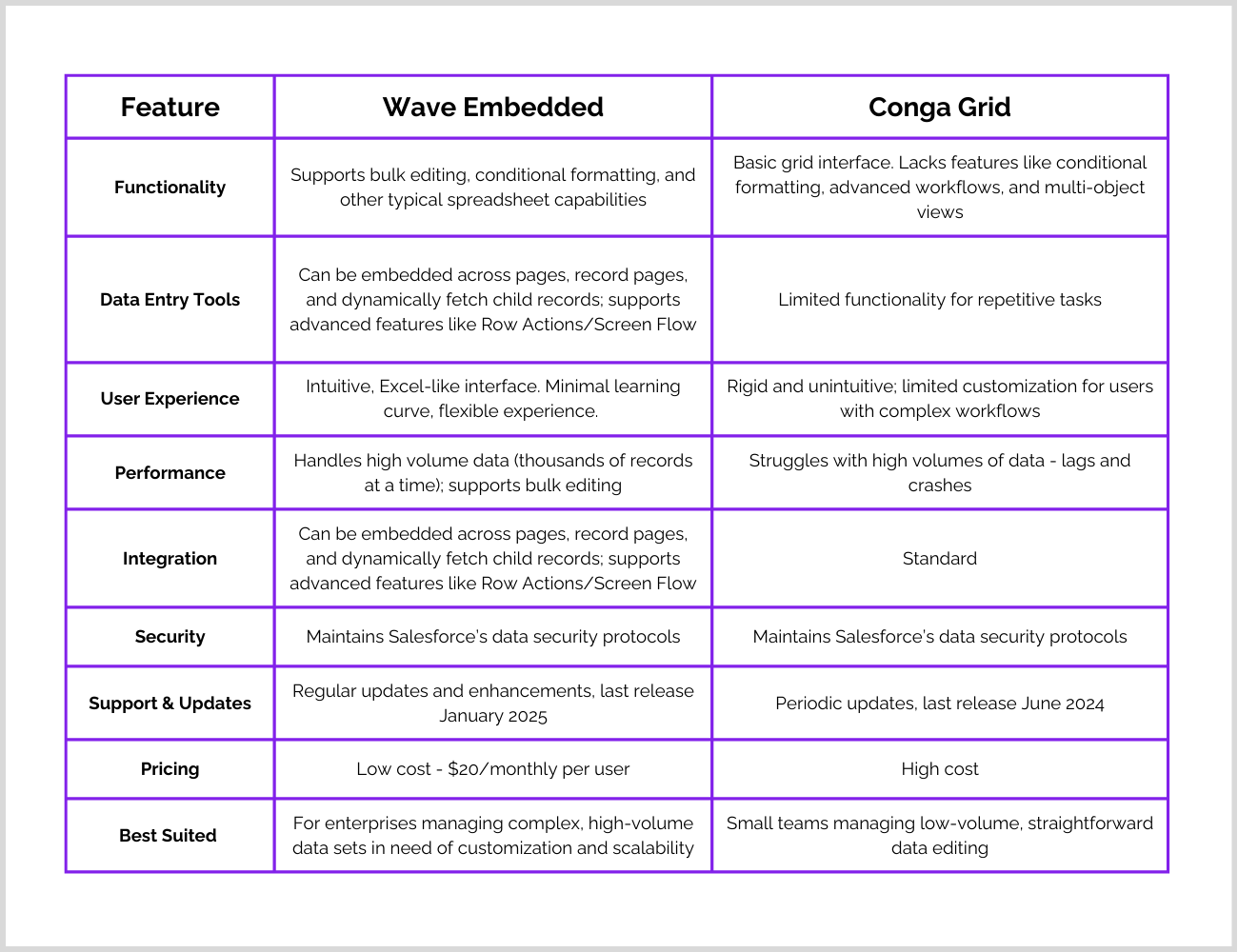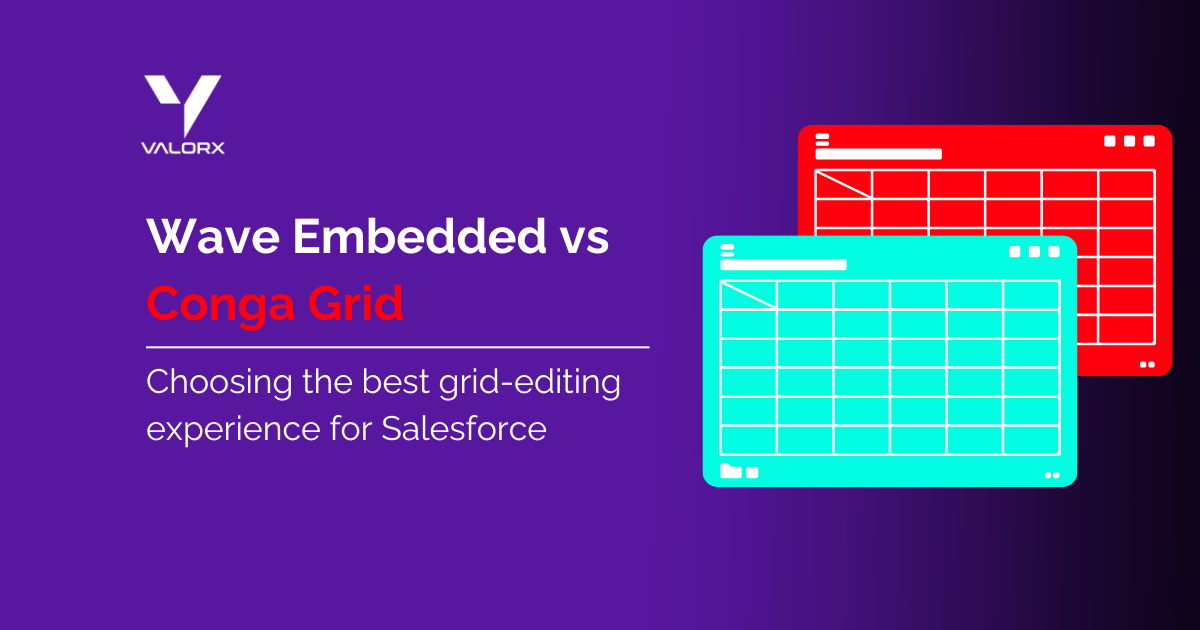As the market leader for business data management, Salesforce is mission-critical for today’s enterprises. Yet despite how powerful and expansive the platform is, managing its data is difficult and can lead to operational bottlenecks without the right tools.
Conga Grid and Wave Embedded both promise to simplify Salesforce data management - but the differences in their functionality, scalability, and impact are significant. Failing to choose the right tool for your needs can slow productivity, increase costs, and hinder growth.
This article compares both solutions to help you determine which one delivers on its promise to streamline your Salesforce data management experience without compromise, maximizing ROI, driving team productivity, and future-proofing your business operations.
Wave Embedded vs. Conga Grid: Features Summary

1. Functionality: Built for basic vs. enterprise needs
Wave Embedded: Built for enterprise-scale challenges, Wave Embedded transforms Salesforce into a spreadsheet-like powerhouse. It integrates Excel-inspired tools - such as drag-and-drop editing, real-time updates, and multi-object views - enabling teams to process complex, high-volume data effortlessly.
Wave Embedded also offers advanced data entry functionalities, including copy, paste, and clone actions, streamlining repetitive tasks and minimizing manual effort. It supports customizable controls tailored to different data types, such as dropdowns for selections, date pickers for scheduling, and formula fields for calculations. These features bring the familiarity and efficiency of Excel directly into Salesforce, empowering teams to handle intricate data workflows with ease and precision.
Conga Grid: Designed for smaller teams, Conga Grid offers a basic grid interface that simplifies bulk updates. While suitable for low-volume tasks, it struggles with high-volume data and lacks features like conditional formatting, advanced workflows, and multi-object views.
Key Takeaway: Enterprises need more than basic tools. Wave Embedded ensures that even thousands of records across multiple objects can be updated in real-time - something Conga Grid cannot achieve reliably.
While functionality determines what a tool can accomplish, user experience determines how easily your teams can leverage it. Let’s see how Conga Grid and Wave Embedded stack up when it comes to ease of adoption and workflow efficiency.
2. User Experience: Intuitive, Customizable, and Adoption-Ready
Wave Embedded: Wave Embedded’s Excel-like design minimizes the learning curve and accelerates adoption. Teams can fully customize views, apply conditional formatting, and seamlessly toggle between Salesforce and the familiar spreadsheet interface, boosting satisfaction and productivity.
Conga Grid: While an improvement over standard Salesforce views, Conga Grid’s rigid, limited interface often feels unintuitive. Its lack of customization leads to slower adoption and frustration for teams managing complex workflows.
Key Takeaway: Business leaders need tools that don’t disrupt workflows and require minimal training. Wave Embedded delivers this with a design teams already know and trust.
3. Performance: Scale Without Compromise
Performance is critical when managing high volumes of Salesforce data.
Wave Embedded: Handle thousands of records efficiently, making complex, multi-object workflows fast and smooth. Key productivity features include Mass Modifier for quick bulk edits and robust data validation that previews changes before saving to prevent errors. The grid can be embedded in various Salesforce pages and displays related records dynamically, allowing direct in-grid edits without switching tabs.
Additional features like Row Actions enable users to trigger logic, update records, and embed components directly within the grid. Supporting Screen Flow, Aura, and LWC, Wave Embedded enhances integration and usability for a seamless experience.
Conga Grid: Performance deteriorates when handling hundreds or thousands of records, often resulting in slowdowns and timeouts that disrupt productivity.
Key Takeaway: For enterprises where speed and reliability are non-negotiable, Wave Embedded ensures performance never becomes a bottleneck.
Optimizing performance is only half the battle. For businesses handling sensitive data, robust security and compliance are just as critical. Here’s how Conga Grid and Wave Embedded compare on protecting your most valuable information.
4. Security and Data Integrity: Eliminating Risks
Wave Embedded: Follows Salesforce's robust security protocols but offers in-app controls, configurable views, and validation steps to support enhanced governance while working within Salesforce. However, like most tools, it allows for offline exports when needed.
Conga Grid: Also adheres to Salesforce’s security standards, including user permissions and validation rules, but allows users to export data offline, increasing the potential for compliance risks if not handled properly.
Key Takeaway: Both tools meet Salesforce’s baseline security, but organizations with strict compliance requirements can benefit from Wave Embedded’s additional in-platform controls to improve data oversight.
5. Support and Updates: Reliability That Scales with You
Wave Embedded: Delivers frequent updates with new features and performance enhancements to keep pace with enterprise demands. Plus, 24/7 enterprise-grade support ensures issues are resolved promptly, minimizing downtime.
Conga Grid: Conga also provides regular updates and customer support resources, though user feedback on support experiences may vary depending on individual cases and service tiers.
Key Takeaway: Both tools offer support and updates, but the level of customer experience can differ based on specific user needs and expectations. It's important to assess which support model aligns best with your organization's requirements for responsiveness and issue resolution.
6. Pricing: Value that pays for itself
While upfront costs often drive decisions, the true cost of inefficiency, errors, and lost productivity can far outweigh initial investments.
Conga Grid: Despite its basic feature set, Conga Grid comes with a relatively high upfront cost. Additionally, limitations in performance, manual inefficiencies, and lack of scalability can lead to increased long-term expenses.
Wave Embedded: Priced very competitively, Wave Embedded offers a lower cost of entry compared to Conga Grid. It delivers significant ROI through faster workflows, reduced manual workloads, and error elimination, making it a cost-effective choice for high-volume organizations.
Key Takeaway: Wave Embedded not only offers a lower upfront cost but also provides long-term value through enhanced productivity and scalability, making it an ideal option for enterprises focused on efficiency and cost control.
Valorx Wave and Conga Grid: Recap
The choice between Conga Grid and Wave Embedded depends on your organization’s scale, complexity, and growth goals:
Conga Grid
- Best suited for smaller teams with basic Salesforce needs.
- Works well for organizations managing low-volume, straightforward workflows.
Wave Embedded
- Designed for enterprises managing complex, high-volume datasets.
- Ideal for teams requiring multi-object views, advanced features, and enterprise-grade security.
- Perfect for leaders prioritizing scalability, measurable ROI, and long-term value.
Choose The Tool That Works Best For You
While Conga Grid offers a solid foundation for Salesforce data management, its limitations in performance, usability, and scalability make it a less suitable choice for growing enterprises.
Wave Embedded provides a scalable, performant solution to manage Salesforce data. From handling high volumes of data to enabling advanced customization and ensuring robust security.
For business leaders seeking a long-term, strategic advantage, Wave Embedded is the clear winner. Get your free trial today.

